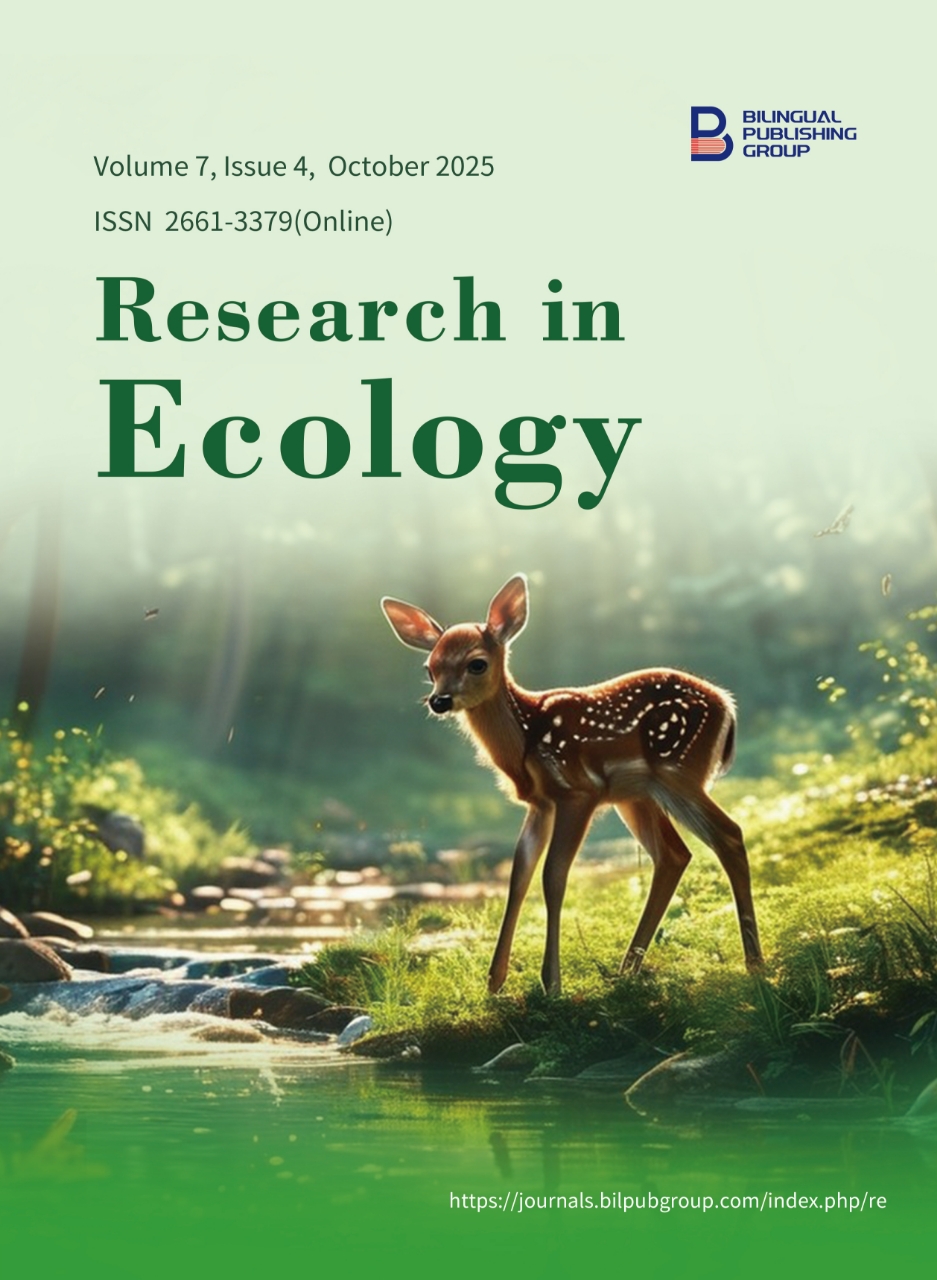
Dew Water as Sustainable Ecological Resource: Mitigating Heavy Metal Pollution in Aquatic Ecosystems and Enhancing Water Security
DOI:
https://doi.org/10.30564/re.v7i4.11148Abstract
Groundwater overextraction and contamination by heavy metals such as cadmium and arsenic have resulted in ecological degradation and increased risks of renal disease, particularly in water-scarce regions. To address these challenges, this review aimed to evaluate the ecological potential of dew water harvesting as a sustainable and safe alternative water source. Literature published between 2000 and 2024 was systematically searched in PubMed, Scopus, Web of Science, and Google Scholar using the terms “dew water,” “atmospheric water harvesting,” “groundwater pollution,” “heavy metals,” “ecosystem restoration,” and “sustainable water systems.” Studies were included if they focused on dew water quality, ecological functions, or health-related outcomes, while non-English publications, conference abstracts without full text, and studies not directly addressing dew water were excluded. A total of 46 studies and 7 official guidelines met the eligibility criteria. Findings indicate that natural dew water generally exhibits a neutral pH (6.5–8.5), negligible concentrations of heavy metals, and relatively high dissolved oxygen content (~9 mg/L). Case studies from Morocco, Israel, China, and India illustrate its contributions to soil moisture retention, plant survival, biodiversity support, and microclimate regulation. Moreover, dew water produced through the Systemized Dew Process (SDP) consistently complied with WHO (2024) standards for drinking water, showing contaminant levels below detection thresholds. In conclusion, dew water harvesting represents a low-impact, climate-resilient, and safe alternative that mitigates exposure to nephrotoxic pollutants, reduces reliance on overexploited groundwater, and enhances long-term ecological restoration and water security in degraded and water-scarce environments.
Keywords:
Ecological Sustainability; Water Conservation; Heavy Metal Pollution; Ecosystem Restoration; Climate Change Adaptation; Renewable Water Sources; Applied EcologyReferences
[1] Wang, C.J., Grantham, J.J., Wetmore, J.B., 2013. The medicinal use of water in renal disease. Kidney International. 84(1), 45–53.
[2] Sharma, R., Kumar, R., Agrawal, P., et al., 2021. Groundwater extractions and climate change. In: Water Conservation in the Era of Global Climate Change. Elsevier: Amsterdam, Netherlands pp. 23–45.
[3] Taufiq, A., Anatoly, N., Rusydi, A., et al., 2024. Groundwater issues and management in Indonesia. Available from: https://www.researchgate.net/publication/382666771 (cited 25 June 2025).
[4] Ghiffari, M.N., Nandita, P.T., 2024. Mengatasi penurunan tanah dan krisis air di Jakarta – Tim Kajian Ekonomi Hijau dan Perubahan Iklim. Environmental Policy Update. 1(3).
[5] Widodo, J., Trihatmoko, E., Setyaningrum, N., et al., 2025. Technical and policy analysis: Time series of land subsidence for the evaluation of the Jakarta groundwater-free zone. Urban Science. 9(3), 67.
[6] Minderhoud, P.S.J., Coumou, L., Erkens, G., et al., 2019. Mekong delta much lower than previously assumed in sea-level rise impact assessments. Nature Communications. 10(1).
[7] Xiao, H., Tang, Y., Li, H., et al., 2021. Saltwater intrusion into groundwater systems in the Mekong Delta and links to global change. Advances in Climate Change Research. 12(3), 342–352.
[8] Zhou, Q., Zhang, J., Fu, J., et al., 2008. Biomonitoring: An appealing tool for assessment of metal pollution in the aquatic ecosystem. Analytica Chimica Acta. 606(2), 135–150.
[9] World Health Organization (WHO), 2011. Guidelines for Drinking-Water Quality. Fourth edition incorporating the first and second addenda. WHO: Geneva, Switzerland.
[10] Wasana, H.M.S., Aluthpatabendi, D., Kularatne, W.M.T.D., et al., 2016. Drinking water quality and chronic kidney disease of unknown etiology (CKDu): Synergic effects of fluoride, cadmium and hardness of water. Environmental Geochemistry and Health. 38(1), 157–168.
[11] Wanigasuriya, K.P., Peiris-John, R.J., Wickremasinghe, R., 2011. Chronic kidney disease of unknown aetiology in Sri Lanka: Is cadmium a likely cause? BMC Nephrology. 12(1), 32.
[12] Feng, H., Gao, Y., Zhao, L., et al., 2013. Biomarkers of renal toxicity caused by exposure to arsenic in drinking water. Environmental Toxicology and Pharmacology. 35(3), 495–501.
[13] Cheng, Y.Y., Chang, Y.T., Cheng, H.L., et al., 2018. Associations between arsenic in drinking water and occurrence of end-stage renal disease with modifications by comorbidities: A nationwide population-based study in Taiwan. Science of The Total Environment. 626, 581–591.
[14] Costanza, R., d’Arge, R., de Groot, R., et al., 1997. The value of the world’s ecosystem services and natural capital. Nature. 387(6630), 253–260.
[15] Neill, A.M., O’Donoghue, C., Stout, J.C., 2020. A natural capital lens for a sustainable bioeconomy: Determining the unrealised and unrecognised services from nature. Sustainability. 12(19), 8033.
[16] Singh, R., Singh, G., 2017. Ecosystem services: A bridging concept of ecology and economics. Ecological Questions. 25, 95.
[17] Sunardi, D., Chandra, D.N., Medise, B.E., et al., 2024. Health effects of alkaline, oxygenated, and demineralized water compared to mineral water among healthy population: A systematic review. Reviews on Environmental Health. 39(2), 339–349.
[18] UNESCO World Water Assessment Programme, 2022. The United Nations World Water Development Report 2022: Groundwater: Making the Invisible Visible. United Nations Educational, Scientific and Cultural Organization, Paris, France.
[19] Brenner, L., 2019. Role of water in the ecosystem. Available from: https://www.sciencing.com/role-water-ecosystem-5444202/ (cited 25 June 2025).
[20] Kılıç, Z., 2020. The importance of water and conscious use of water. International Journal of Hydrology. 4(5), 239–241.
[21] Gordon, B., Boisson, S., Johnston, R., et al., 2023. Unsafe water, sanitation and hygiene: A persistent health burden. Bulletin of the World Health Organization. 101(9), 551–551A.
[22] Cheng, Y.Y., Huang, N.C., Chang, Y.T., et al., 2017. Associations between arsenic in drinking water and the progression of chronic kidney disease: A nationwide study in Taiwan. Journal of Hazardous Materials. 321, 432–439.
[23] Filler, G., Roach, E., Yasin, A., et al., 2012. High prevalence of elevated lead levels in pediatric dialysis patients. Pediatric Nephrology. 27(9), 1551–1556.
[24] Chen, J.W., Chen, H.Y., Li, W.F., et al., 2011. The association between total urinary arsenic concentration and renal dysfunction in a community-based population from central Taiwan. Chemosphere. 84(1), 17–24.
[25] Mandour, R.A., 2012. Human health impacts of drinking water (surface and ground) pollution Dakahlyia Governorate, Egypt. Applied Water Science. 2(3), 157–163.
[26] Beysens, D., 2022. Dew Water. River Publishers, New York, NY, USA.
[27] Muselli, M., Clus, O., Ortega, P., et al., 2021. Physical, chemical and biological characteristics of dew and rainwater during the dry season of tropical islands. Atmosphere (Basel). 12(1), 69.
[28] Wang, L., Kaseke, K.F., Ravi, S., et al., 2019. Convergent vegetation fog and dew water use in the Namib Desert. Ecohydrology. 12(7).
[29] Muselli, M., Beysens, D., Soyeux, E., et al., 2006. Is dew water potable? Chemical and biological analyses of dew water in Ajaccio (Corsica Island, France). Journal of Environmental Quality. 35(5), 1812–1817.
[30] Schilling, J., Hertig, E., Tramblay, Y., et al., 2020. Climate change vulnerability, water resources and social implications in North Africa. Regional Environmental Change. 20(1), 15.
[31] Tahiri, A., Amraoui, F., Sinan, M., et al., 2022. Influence of climate variability on water resource availability in the upper basin of Oum-Er-Rabiaa, Morocco. Groundwater for Sustainable Development. 19, 100814.
[32] Kidron, G.J., Starinsky, A., 2012. Chemical composition of dew and rain in an extreme desert (Negev): Cobbles serve as sink for nutrients. Journal of Hydrology. 420–421, 284–291.
[33] Polkowska, Z., Błaś, M., Klimaszewska, K., et al., 2008. Chemical characterization of dew water collected in different geographic regions of Poland. Sensors. 8(6), 4006–4032.
[34] Yadav, S., Kumar, P., 2014. Pollutant scavenging in dew water collected from an urban environment and related implications. Air Quality, Atmosphere & Health. 7(4), 559–566.
[35] Shohel, M., Simol, H.A., Reid, E., et al., 2017. Dew water chemical composition and source characterization in the IGP outflow location (coastal Bhola, Bangladesh). Air Quality, Atmosphere & Health. 10(8), 981–990.
[36] Xu, Y., Zhu, H., Tang, J., et al., 2015. Chemical compositions of dew and scavenging of particles in Changchun, China. Advances in Meteorology. 2015, 1–9.
[37] Muselli, M., Lekouch, I., Beysens, D., 2022. Physical and chemical characteristics of dew and rain in North-West Africa with focus on Morocco: Mapping past and future evolution (2005–2100). Atmosphere. 13(12), 1974.
[38] Hong, L., Zhu, B., Yu, X., et al., 2019. Chemical composition of dew water at a suburban site in Nanjing, China, during the 2016–2017 winter. Atmospheric Environment. 211, 226–233.
[39] World Health Organization, 2024. Guidelines for Drinking-Water Quality - Small Water Supplies. World Health Organization: Geneva, Switzerland.
[40] Pemerintah Pusat Indonesia, 2001. Peraturan Pemerintah (PP) Nomor 82 Tahun 2001 tentang Pengelolaan Kualitas Air Dan Pengendalian Pencemaran Air. In: Peraturan Perundang-undangan Lingkungan Hidup. Jakarta, Indonesia.
[41] BPOM, 2019. Peraturan Badan Pengawas Obat dan Makanan Nomor 34 Tahun 2019 Tentang Kategori Pangan. Badan Pengawas Obat dan Makanan: Jakarta, Indonesia.
[42] Fang, C.H., Tsai, C.C., Shyong, Y.J., et al., 2020. Effects of highly oxygenated water in a hyperuricemia rat model. Journal of Healthcare Engineering. 2020, 1–8.
[43] Nakamura, Y., Watanabe, H., Tanaka, A., et al., 2020. Effect of increased daily water intake and hydration on health in Japanese adults. Nutrients. 12(4).
[44] Forth, W., Adam, O., 2001. Uptake of oxygen from the intestine—experiments with rabbits. European Journal of Medical Research. 6(11), 488–492.
[45] Sommer, A.M., Bogusch, C., Lerchl, A., 2007. Cognitive function in outbred house mice after 22 weeks of drinking oxygenated water. Physiology & Behavior. 91(1), 173–179.
[46] Izawa, H., Nagao, M., Nozu, S., et al., 2022. Effects of drinking oxygenated water on blood oxygen saturation during exercise under normobaric hypoxic conditions: A randomized placebo-controlled single-blinded trial. Juntendo Medical Journal. 68(3), 228–234.
[47] Mackenzie, J.S., Jeggo, M., 2019. The One Health approach—why is it so important? Tropical Medicine and Infectious Disease. 4(2).
[48] Danasekaran, R., 2024. One Health: A holistic approach to tackling global health issues. Indian Journal of Community Medicine. 49(2), 260–263.
[49] Healing Waters International, 2025. Why is clean water important to communities. Available from: https://healingwaters.org/why-do-communities-need-clean-water/ (cited 25 June 2025).
[50] Fessahaye, A.K., Xie, Y., Hu, Y., et al., 2025. Groundwater over-extraction: Comprehensive review of socio-economic impacts and pathways to sustainable management. European Journal of Theoretical and Applied Sciences. 3(2), 190–211. Available from: https://ejtas.com/index.php/journal/article/view/1491
[51] Famiglietti, J.S., 2014. The global groundwater crisis. Nature Climate Change. 4(11), 945–948.
[52] Tomaszkiewicz, M., Abou Najm, M., Beysens, D., et al., 2015. Dew as a sustainable non-conventional water resource: a critical review. Environmental Reviews. 23(4), 425–442.
[53] Sharan, G., Roy, A.K., Royon, L., et al., 2017. Dew plant for bottling water. Journal of Cleaner Production. 155, 83–92.
[54] Kidron, G.J., Herrnstadt, I., Barzilay, E., 2002. The role of dew as a moisture source for sand microbiotic crusts in the Negev Desert, Israel. Journal of Arid Environments. 52(4), 517–533.
[55] Ravi, S., Breshears, D.D., Huxman, T.E., et al., 2010. Land degradation in drylands: Interactions among hydrologic–aeolian erosion and vegetation dynamics. Geomorphology. 116(3–4), 236–245.
[56] Lal, R., 2013. Climate-resilient agriculture and agroforestry. In: Handbook of Climate Change and Agroecosystems. Imperial College Press: London, UK. pp. 287–306.
[57] Angelakis, A.N., Tchobanoglous, G., Capodaglio, A.G., et al., 2024. The importance of nonconventional water resources under water scarcity. Water (Basel). 16(7), 1015.
[58] Kaseke, K.F., Wang, L., 2018. Fog and dew as potable water resources: Maximizing harvesting potential and water quality concerns. GeoHealth. 2(10), 327–332.
[59] Khalil, B., Adamowski, J., Shabbir, A., et al., 2016. A review: dew water collection from radiative passive collectors to recent developments of active collectors. Sustainable Water Resources Management. 2(1), 71–86.
[60] Tomaszkiewicz, M., Abou Najm, M., Zurayk, R., et al., 2017. Dew as an adaptation measure to meet water demand in agriculture and reforestation. Agricultural and Forest Meteorology. 232, 411–421.
[61] Amparo-Salcedo, M., Pérez-Gimeno, A., Navarro-Pedreño, J., 2025. Water security under climate change: Challenges and solutions across 43 countries. Water (Basel). 17(5), 633.
[62] Schemenauer, R.S., Cereceda, P., 1994. A proposed standard fog collector for use in high-elevation regions. Journal of Applied Meteorology. 33(11), 1313–1322. DOI: https://doi.org/10.1175/1520-0450(1994)033%3C1313:APSFCF%3E2.0.CO;2
[63] Klemm, O., Schemenauer, R.S., Lummerich, A., et al., 2012. Fog as a fresh-water resource: Overview and perspectives. Ambio. 41(3), 221–234.
[64] Meraj, G., Kanga, S., Kranjčić, N., et al., 2021. Role of natural capital economics for sustainable management of earth resources. Earth. 2(3), 622–634.
[65] Ghimire, S.R., Johnston, J.M., 2017. Holistic impact assessment and cost savings of rainwater harvesting at the watershed scale. Elementa: Science of the Anthropocene. 5(9). DOI: https://doi.org/10.1525/elementa.135
Downloads
How to Cite
Issue
Article Type
License
Copyright © 2025 Jonny Jonny, Pepita Zenia, Fachira Rachel Agfata

This is an open access article under the Creative Commons Attribution-NonCommercial 4.0 International (CC BY-NC 4.0) License.




 Jonny Jonny
Jonny Jonny






